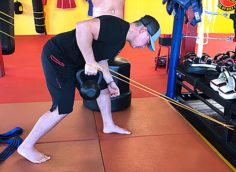I never gave much mind to stretch bands of any kind. For one thing, they don't make any satisfying clanking noises. At best, you get an occasional muted twang. Besides, no one, in the entire history of mankind, has ever asked anybody how much he or she can stretch.
Enter the pandemic. Like millions of others, I had to start working out from home, so I set up a small gym on a concrete slab next to my tool shed. I got a power rack, a bench, and a rusty Olympic set. I got some Powerblocks and a couple of kettlebells. I got pruning shears and some mulch.
That all worked out fine for a while, but I started to miss having access to cable stacks and the bazillion or so exercises you can do with them.
So I reluctantly bought a shit load of stretch bands – not the ones that are made of shiny, thin, Neoprene rubber, but thick, fat ones that look like something King Kong's sister uses to tie back her hair while she's washing her face, or what you'd use to sling-shot a Chrysler across a football field.
And glory be, they've opened up a whole new world of training for me. Not only can I replicate almost any cable-stack movement, whether they're triceps pushdowns, delt raises, or cable flyes, I can actually do many of them more effectively.
I can even use stretch bands to do leg extensions and leg curls and for the first time ever, I can do them comfortably – the motion is determined entirely by my own anatomy and not the length and angle of welded pieces of metal cut to some arbitrary lengths.
I even found that certain stretch band exercises are superior to some highly respected, serious exercises. Case in point, I found that stretch band pull-throughs are far better suited to work the glutes and hamstrings than kettlebell swings or hip thrusts. For real. Let me make my case.
Kettlebell swings are great... for building explosive strength, increasing work capacity, and even burning calories. They even appear to activate muscle much more than other hinge exercises. However, as far as creating muscle in the glutes or hammies, they're kind of a bust.

During a kettlebell swing, the initial powerful hip thrust propels the bell upwards until it reaches an apogee, but then, like a rocket ship that ran out of fuel, it plummets downward at the speed of a falling rock, which is 9.8 m/s/s.
There's no significant time under tension and there's no eccentric component, and any movement that completely lacks those two components isn't going to grow much muscle.
Hip thrusts are nice because you get to lie on your back and check your Twitter feed. As far as disadvantages, they're a pain in the ass to set up. The range of motion sucks and most people seem to have trouble "feeling" them, probably because of hip mobility issues or difficulty in smoothly controlling the ascent and descent of the bar.

There's also the issue of the weight digging into your pelvis, eventually creating a furrow or canal across your hips through which small boats can pass through on their way to the West Coast.
Pull-throughs, done with cables or stretch bands, allow for constant tension throughout the whole damn movement and it's this extensive time under tension that allows for muscle growth.
This stands in stark contrast with kettlebell swings where the load is spread out across not only the hamstrings, but tendons and ligaments too.
While hip thrusts allow for greater time under tension than kettlebell swings, cable or stretch bands provide constant tension through the whole range of motion, which can only be duplicated in the hip thrust by really loading up the bar, at which point most people start to lose control and the "feel" of the exercise.
The biggest advantage conveyed by pull-throughs, specifically those done with a stretch band, is the ability to go "full-Mentzer" on them. By that I mean you can rep-out, immediately scootch your feet back a couple of inches, rep out again, and continue scootching and repping until your backside ignites in flames and sets the sprinkler on and turns the gym into a giant wet T-shirt contest.
You could do something similar with cable pull-throughs by pulling the pin and "going down the ladder" of the weight stack, but it would require you to stop the exercise, pull the pin, and re-set before continuing.
- Loop the stretch band to an immovable object.
- Face away from the point of attachment and assume a shoulder-width stance.
- Hinge back and grab onto the stretch band with both hands.
- "Screw" the feet into the ground and try to spread the floor apart.
- Hinge forward at the hips and when you reach full extension, pause for a couple of seconds and imagine trying to crack a walnut or coconut, as the case may be, between your butt cheeks.
- Allow the cable to slowly travel back along the same path.
- When you reach failure, scootch back an inch or two and continue until total failure.
- Sit on an ice pack.
T Nation earns from qualifying purchases as an Amazon Associate. Read more about our policy.





